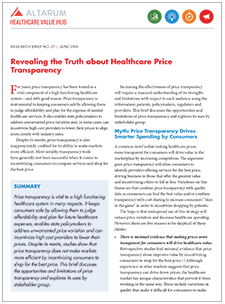Improving Value
Transparency Initiatives
Our health care system is notoriously opaque when it comes to how our health care dollars are spent.
Consumers can rarely find out the complete cost of their medical care ahead of time. What’s more, they may even be unable to determine whether all the providers treating them are in their plan’s network prior to receiving services.1
Similarly, providers are often in the dark as to prevailing prices being paid by health insurers or even what a bundle of care at their own organization might cost. Confidentiality clauses and so-called “gag clauses” in provider-insurer contracts can ensure that knowledge of negotiated prices stay between the parties in the contract. Insurers may also seek to protect the confidentiality of their prices as a “trade secret.”2 Additionally, medical device manufacturers often require hospitals to sign confidentiality agreements, making those prices opaque.
There is considerable debate over whether and how much increased transparency in the health system could improve value, even in the absence of any other intervention.
While often thought of as an exercise in putting price data in front of consumers, in reality the transparency question is much broader, having these dimensions:
| Audience for Information | What is transparent? |
| Consumers | Prices |
| Providers | Quality |
| Researchers | Value |
| Policymakers/Regulators | Comparative Effectiveness of Treatment Options |
| Insurers | Provider conflict-of-interest data |
Price Transparency
Price transparency is often touted as a vital component of a high functioning health care system—and with good reason. Price transparency is instrumental to keeping consumers safe in the health care marketplace by allowing them to judge affordability and plan for the expense of needed health care services. It also enables state policymakers to address unwarranted price variation and, in some cases, can incentivize high cost providers to lower their prices to align more closely with industry rates.
Despite its merits, price transparency is also inappropriately credited for its ability to make markets more efficient. Most notably, consumer-facing price transparency tools have generally not been successful when it comes to incentivizing consumers to compare services and shop for the best price.
Increasing the effectiveness of price transparency will require a nuanced understanding of its strengths and limitations with respect to each audience using the information: patients, policymakers, regulators and providers. This brief discusses the opportunities and limitations of price transparency and explores its uses by stakeholder group.
Quality Transparency
Case studies suggest that, under the right circumstances, public reporting of quality metrics can lead to improvements in the quality of care that hospitals and clinicians provide.3 Hospital executives state that quality reports and hospital comparisons help them focus their quality efforts.4 Evidence also suggests that individual clinicians and physician organizations respond to public reporting in positive ways, including adding services, changing policy and increasing focus on clinical care. There is comparatively less evidence, however, supporting the claim that quality transparency affects patients’ choice of provider.5
Despite anecdotal evidence of effectiveness, determining the impact of public reporting on quality is difficult for a number of reasons. Barriers include: lack of randomized controlled trials and results weakened by delays between the times performance indicators are announced and when reporting begins (allowing providers to jumpstart improvement activities before baseline performance is actually measured).6
Conflicts of Interest
Another important form of transparency is the public disclosure of conflicts of interest. Conflicts of interest occur when physicians enter financial relationships with other industry stakeholders, such as:
- accepting gifts from individuals like pharmaceutical sales representatives, including meals and drug samples;
- having a financial interest in a medical product company whose products they prescribe, use, or recommend; and
- acting as promotional speakers or writers on behalf of medical product companies.7
Disclosure policies are commonly used to regulate conflicts-of-interest. Limited evidence suggests that, while they could go farther, these policies effectively curtail referrals and treatment decisions that represent a conflict.8
Notes
1. See http://consumersunion.org/surprise-medical-bills/
3. See: Roland, Martin, and R. Adams Dudley, “How Financial and Reputational Incentives Can Be Used to Improve Medical Care,” Health Services Research, Vol. 50, No. 2 (December 2015) and Hibbard, Judith H., Jean Stockard and Martin Tusler, “Does Publicizing Hospital Performance Stimulate Quality Improvement Efforts?” Health Affairs, Vol. 22, No. 2 (March/April 2003).
4. Mary Laschober, Myles Maxfield, Suzanne Felt-Lisk, and David J. Miranda, "Hospital Response to Public Reporting of Quality Indicators," Healthcare Financing Review, Spring 2007, Volume 28.
6. Roland and Dudley (December 2015). See also: https://healthcarevaluehub.org/advocate-resources/publications/non-financial-provider-incentives-looking-beyond-provider-payment-reform/#note3
7. There is a large volume research indicating that self-referral has a major effect on increasing medical costs. Levin, David C.; Rao, Vijay M., "Turf Wars in Radiology: Updated Evidence on the Relationship Between Self-Referral and the Overutilization of Imaging," Journal of the American College of Radiology 5 (7): 806–810
8. Matthew Chao, Regulating Conflicts of Interest through Public Disclosure: Evidence from a Physician Payments Sunshine Law, California Institute of Technology (February 2015).







